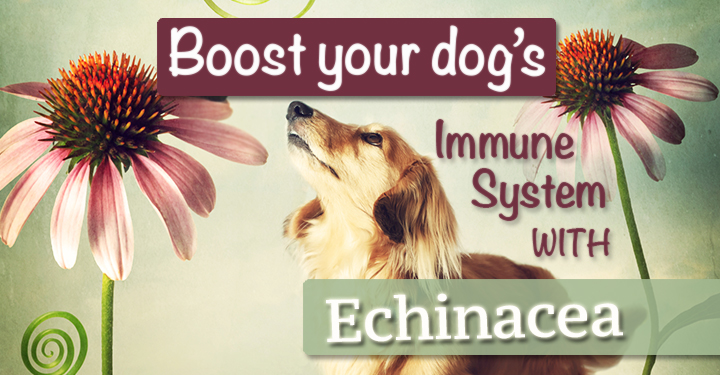You notice your dog is suddenly not himself.
He’s dragging himself around and doesn’t have that typical bright look in his eye.
Clearly, his immune system is fighting something.
Do you reach for the echinacea?
What Is Echinacea?
Here’s an interesting bit of trivia.
Echinacea (purple coneflower) was “discovered” in the late 1800’s by a traveling salesman named Joseph Meyer. He learned about it from the Plains Indians while traveling. Meyer brewed it up as an alcohol tincture and sold it as a cure-all. He even proved its effectiveness by drinking his tonic and letting rattlesnakes bite him. He never got sick … and that was the start of the phrase “snake oil salesman.”
Like Joseph Meyer, you may also know echinacea is a great immune booster … and that’s certainly true.
But how you use echinacea will determine how well it works for your dog.
So first, you need to understand how echinacea works.
How Does Echinacea Boost The Immune System?
There are a lot of immune-boosting herbs and they work in different ways. The way echinacea works is really interesting.
First, it contains echinacoside, a natural antibiotic that works the same as penicillin; so it can kill a broad range of viruses, bacteria, fungi, and protozoa. This makes it a really valuable herb to have around for wound healing and sick dogs. Echinacea also contains echinacein, which protects against germy attacks by neutralizing the tissue-dissolving enzyme hyaluronidase, which germs produce.
If you like technical explanations, echinacea can increase macrophage activation — by increasing production of interferon gamma. In addition, one study showed that Echinacea extracts can boost T-cell production by up to 30 percent more than immune boosting drugs. Echinacea also increases production of the chemokines interleukin-8 and MCP-1, which enhance the migration of immune cells to the site of infection.
So What Does All That Mean?
When your dog is exposed to things like kennel cough or bacteria, his immune system fires up its defenses to fight those bugs. Echinacea works the same way … but it actually offers no threat to the body at all.
So when you give your dog echinacea, his immune system perceives it as a threat and powers up. But because echinacea isn’t harmful to the body at all, the immune system has nothing to attack … so it stays charged up on standby, waiting for a threat to arrive so it can pounce on it.
But there’s a downside to this type of immune booster …
Sooner or later, your dog’s immune system figures out you’ve been yanking its chain and stops responding to the echinacea.
So when you’re using immune boosters like echinacea, it’s a good idea to use them off and on … or your dog’s immune system will catch on to your trickery. Herbalist Greg Tilford recommends five days on and two to three days off.
When you take this time off, your dog’s immune system will forget all about that false threat and you can pull its leg over and over again, keeping it on high alert.
Timing Is Everything
Timing is critical to success. To work, echinacea must be given while your dog is incubating sickness, not when he’s full-out sick. So it’s important to look at and feel your dog every day to catch the early signs of illness – then you can jump on the echinacea and know it will help him. Once your dog shows full-out symptoms of illness, his immune system will already be responding, so there’s no point in giving him echinacea.
The key to echinacea is ramping up the immune system before illness strikes!
So consider adding echinacea daily for a week or two, then a few days off. Some studies show that daily doses of echinacea can extend lifespan and reduce the growth of cancer cells, so it’s an important addition to your dog’s diet. Or you can give it to your dog when he’s traveling, under stress or any other time when his immune system could come under attack.
Is Echinacea Safe? That Depends!
Some dogs can be sensitive to the antigens in echinacea and you may see allergy symptoms. These dogs shouldn’t take echinacea. Also, many dogs suffer from immune mediated diseases and echinacea can aggravate these diseases. So if your dog has this type of chronic disease, it’s best to check with your holistic vet before giving him echinacea.
But it’s important to understand the power of echinacea really relies on a healthy immune system. If your dog is healthy, then echinacea will work great to boost his ability to fight disease before it happens.
How Much Should I Give?
There are two main varieties of echinacea: purpurea and angustifolia. They’re similar, but also have complementary properties. Formulas that use both are more likely to be effective. It’s also worth noting that most of echinacea’s immune boosting power is in the seeds and root.
For dogs, give 12 to 25 drops of echinacea tincture, three times daily.












